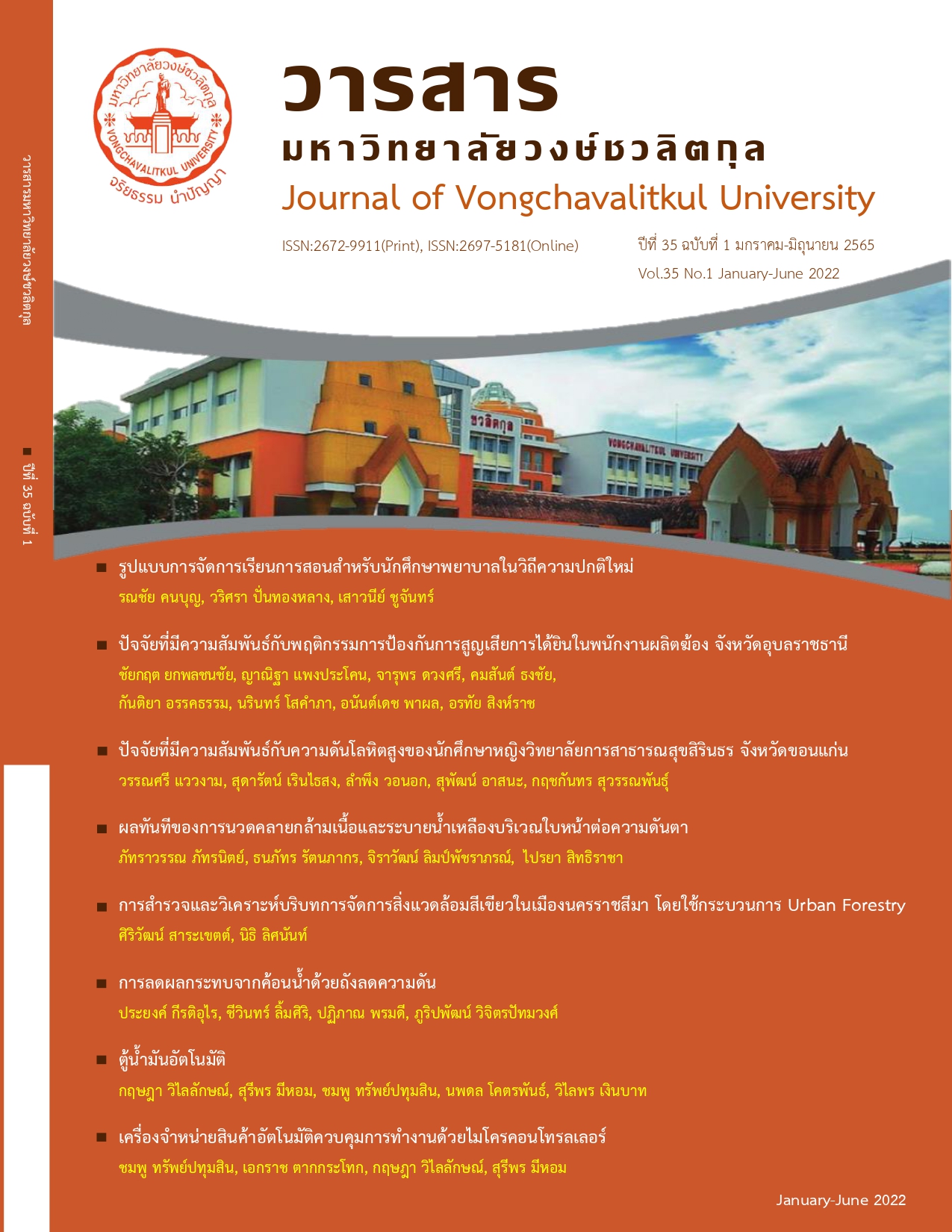Reduction of Water Hammer Impact with Surge Tank
Main Article Content
Abstract
Abstract
Objective: To evaluate the difference in reducing the impact of water hammer with the surge tank application with and without a flexible diaphragm.
Methods: The water hammer were simulated from 0.5 HP water pump, head maximum to 20 meters and control valve to adjust the flow rate. The water flowed through the PVC main pipes with ½ inch, ¾ inch, and 1 inch pipe sizes. The length of the PVC main pipe was 4 meters each. The study results were collected from pressure values at the surge tanks. The surge tanks were made out of PVC pipes. The pressure reduction values were compared in with and without the flexible diaphragm. The surge tanks studied were available in ½-inch, ¾-inch, 1-inch, 1.5-inch, and 2-inch sizes. The lengths of the surge tanks were 50, 75, 100 centimeters and were tested at each size of the surge tanks.
Results: The water hammer pressure reduction efficiencies were 2%-5%, 7%-15%, and 20%-40% for ½ inch, ¾ inch, and 1 inch pipe sizes, respectively. These efficiencies were directly proportional to the diameters and lengths of the surge tanks, both without and with flexible diaphragm. The flexible diaphragm could reduce the pressure with the higher efficiency of 2%-7% than the without flexible diaphragm. Because of the water supply pipe sizes were inversely proportional to the pressure generated in the pipe system. Therefore, the sizes of the main water supply pipes affect the efficiency of reducing pressure. The water pressure reduction efficiencies were 20%-55%, 7%-29%, and 2%-10% for 1 inch, ¾ inch, and ½ inch of the main water supply pipe sizes, respectively. In addition, the design of the surge tanks length that took into account the energy loss due to friction in the pipelines could achieves the less maximum length of the surge tank than to ignore the loss of energy due to friction in the pipe.
Article Details

This work is licensed under a Creative Commons Attribution-NonCommercial-NoDerivatives 4.0 International License.
References
กีรติ ลีวัจนกุล. (2545). วิศวกรรมชลศาสตร์ (พิมพ์ครั้งที่ 3). ปทุมธานี: สำนักพิมพ์ SPEC.
ชมรมวิศวกรออกแบบระบบสุขาภิบาล. (2559). Water Hammer คืออะไร. สืบค้นเมื่อวันที่ 27ธันวาคม 2562, จาก https://www.facebook.com/1223496287678630/posts/
นิพนธ์ ลักขณาอดิศร. (2555). Water Hammer. วารสาร TPA News, (191), 52-53. สืบค้นเมื่อวันที่ 27 ธันวาคม 2562, จาก http://www.tpa.or.th/tpanews/upload/mag_content/62/ContentFile1154.pdf
พนิดา สีมาวุธ. (2564). ศึกษาผลของการเลือกใช้วาล์วน้ำล้นและวาล์วส่งน้ำต่อ ประสิทธิภาพการทำงานของเครื่องตะบันน้ำ. การประชุมวิชาการวิศวกรรมโยธาแห่งชาติ ครั้งที่ 26. INF-07-(1-6). การประชุมรูปแบบออนไลน์: วิศวกรรม สถานแห่งประเทศไทย ในพระบรม ราชูปถัมภ์ (วสท.) ร่วมกับ ภาควิชาวิศวกรรมโยธา คณะวิศวกรรมศาสตร์ สถาบันเทคโนโลยีเจ้าคุณทหารลาดกระบัง (สจล.).
มัชฌิมะ สิทธิโห. (2557). การประยุกต์ใช้ปั๊มกระแทกน้ำเพื่อลดค่าใช้จ่ายด้าน พลังงาน. สืบค้นเมื่อวันที่ 4 ธันวาคม 2563, จาก http://kmlo.crma.ac.th/ kmnew/wp-content/uploads/2018/05/km57_15.pdf
วริทธิ์ อึ๊งภากรณ์. (2541). การออกแบบระบบท่อภายในอาคาร. กรุงเทพฯ: สมาคม วิศวกรรมสถานแห่งประเทศไทย.
ปริวัสส์ เอื้อนสะอาด, วราวุธ วุฒิวณิชย์ และจิระกานต์ ศิริวิชญ์ไมตรี. (2555). การ วิจัยและพัฒนาเครื่องตะบันนํ้าแบบประหยัด (ปริญญานิพนธ์ปริญญาบัณฑิต). มหาวิทยาลัยเกษตรศาสตร์วิทยาเขตกำแพงแสน. นครปฐม.
ศิริเจษฎ์ กองแก้ว. (2558). ปั๊มสูบนํ้าอัตโนมัติโดยใช้พลังงานธรรมชาติจากน้ำ (รายงานผลการวิจัย). พระนครศรีอยุธยา: มหาวิทยาลัยเทคโนโลยีราชมงคลสุวรรณภูมิ.
สุนทร วงศ์เสน. (2559). การศึกษาประสิทธิภาพเครื่องตะบันน้ำ (รายงานผลการวิจัย). กรุงเทพฯ: สถาบันรัชต์ภาคย์.
Darcy, H. (1857). Recherches expérimentales relatives au mouvement de l'eau dans les tuyaux. Paris: Mallet-Bachelier. 268 pages and atlas (in French).
Glenn, O. Brown. (2002). The History of the Darcy-Weisbach Equation for Pipe Flow Resistance. Environmental and Water Resources History, Sessions at ASCE Civil Engineering Conference and Exposition 2002, pp 34-43, DOI:10.1061/40650(2003)4
Prayong Keeratiurai. (2013). The Quality Management in the Building Sanitation. European Journal of Scientific Research, 112(3), 375-386.
SCG Brand. (2559). แก้ปัญหาเสียงดังในท่อประปาจากแรงดันน้ำ. สืบค้นเมื่อวันที่ 28 ธันวาคม 2562, จาก https://th-th.facebook.com/SCGBrand/posts/916678408463491
Weisbach, J. (1845). Lehrbuch der Ingenieur- und Maschinen-Mechanik, Vol. 1. Braunschweig: Theoretische Mechanik, Vieweg und Sohn. 535 pages (in German).


